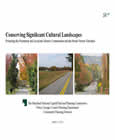Conserving Significant Cultural Landscapes: Protecting the Piscataway and Accokeek Historic Communities and the Mount Vernon Viewshed

Title:
Conserving Significant Cultural Landscapes: Protecting the Piscataway and Accokeek Historic Communities and the Mount Vernon Viewshed
Author:
The Maryland-National Capital Park and Planning Commission
Prince George's County Planning Department
Publication Date:
03/01/2013
Source of Copies:
The Maryland-National Capital Park and Planning Commission
14741 Governor Oden Bowie Drive
Upper Marlboro, MD 20772
Number of Pages:
51
This study provides recommendations for conserving the cultural landscape of the rural communities of Piscataway and Accokeek, which are a portion of a significant viewshed across the Potomac River from the porch of Mount Vernon. Mount Vernon, located in Fairfax County, Virginia, is the historic home and Potomac riverfront plantation of George Washington, the nation’s first president. It is one of the most important historic sites in the nation, receiving more than a million visitors each year, and the view across the Potomac River into southern Maryland is a key element of any visit to the site. The sweeping panorama or viewshed, also called the Mount Vernon Viewshed Area of Primary Concern, covers portions of Prince Georges and Charles Counties, making them important components of the environmental setting of a national historic landmark and a candidate for World Heritage site designation. As seen from Mount Vernon, the Piscataway-Accokeek area has remained largely unchanged since the 18th century while locally under an extensive tree canopy. The area has moved into the 21st century as a rural enclave in Prince Georges County, but development now threatens its cultural and historic integrity. The recommendations of this study focus on facilitating appropriate land development in two rural and historic communities in order to maintain and conserve the tree canopy coverage within the Mount Vernon Viewshed Area of Primary Concern, which would retain the local character and livability of these communities while preserving the historic, cultural landscape view.

 Mt Vernon viewshed web
Mt Vernon viewshed web